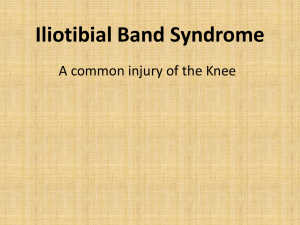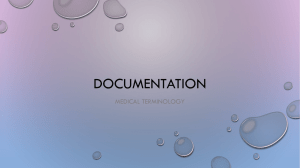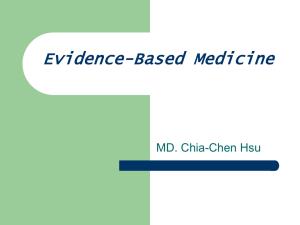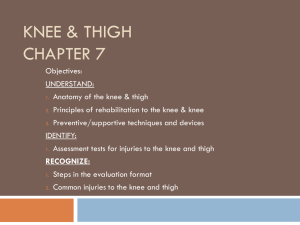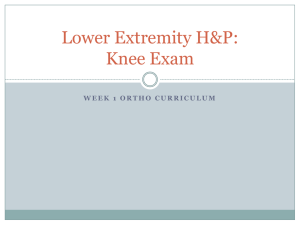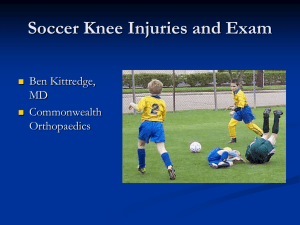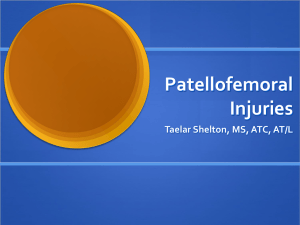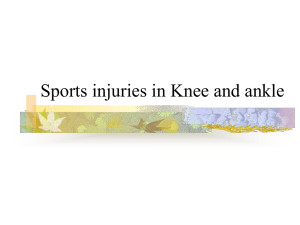rectus
advertisement
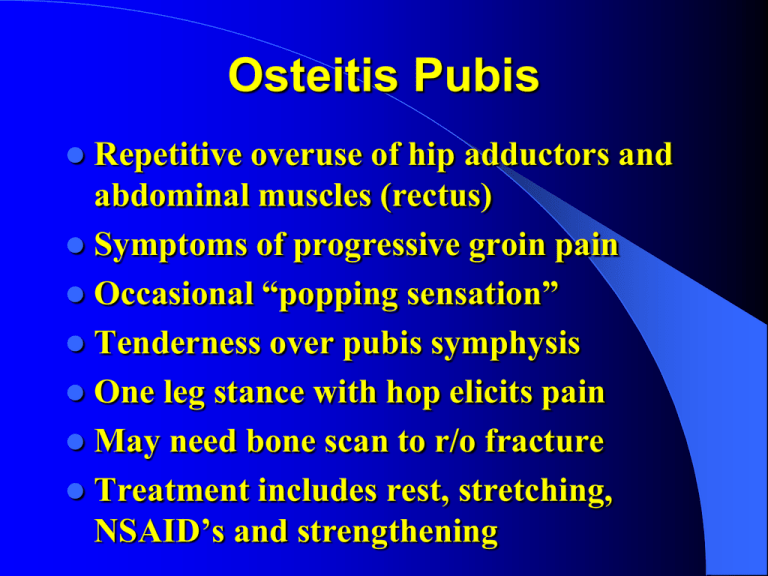
Osteitis Pubis Repetitive overuse of hip adductors and abdominal muscles (rectus) Symptoms of progressive groin pain Occasional “popping sensation” Tenderness over pubis symphysis One leg stance with hop elicits pain May need bone scan to r/o fracture Treatment includes rest, stretching, NSAID’s and strengthening Osteitis Pubis rectus adductors Pediatric And Adolescent Injuries Or Conditions At The Thigh Iliotibial band syndrome Myosytis ossificans Iliotibial band Gerdy’s tubercle Iliotibial Band Syndrome Relatively common among long distance runners Overuse of knee in flexion/extension Provokes swelling underneath the ITB and ITB itself Appears friction from repetitive flexion/extension causes impingement Iliotibial Band Syndrome Predisposition Increase in quality and quantity of training Improper warm up and stretching Too much downhill running Worn out shoes Running in same direction on banked track Excessive pronation Iliotibial Band Syndrome Physical Exam Lateral knee pain Lateral thigh pain Pain after running Tenderness at lateral epicondyle or Gerdy’s tubercle or along entire ITB Ober test Iliotibial Band Syndrome Treatment Stretches Modalities NSAID’s Correction of training errors Myositis Ossificans Heterotopic bone formation caused by deep muscle contusion especially after large hematoma Most common in Quadriceps Myositis Ossificans Follows injury by 3-6 weeks May remodel or reabsorb over 6 to 12 months May need bone scan to detect activity Myositis Ossificans Treatment PRICES (protection, rest, ice, compression, elevation, support) Early on no massage or heat ( can worsen) Myositis Ossificans Excision rarely -After maturation usually > 1yr -Check bone scan if needed to be done sooner -If excised early can reoccur Pediatric Injuries And Conditions Around The Knee Osteochondritis Dissecans Osgood-Schlatter Disease Sinding-LarsenJohansson Syndrome Jumper’s knee Discoid meniscus Patellar femoral pain syndrome Plica Torn ACL Meniscal tears Patellar dislocation Osteochondritis Dissicans Can occur at the knee, ankle or elbow Most commonly seen in the knee at the lateral aspect of medial femoral condyle Etiology ? Thought to be a result of trauma to a flexed knee Results in the separation of an abnormal ossification area within the epiphysis covered by articular cartilage Osteochondritis Dissicans Boys more common than girls Localized pain, effusion, locking and giving way Younger patients have best prognosis Treatment: usually requires surgical intervention Osteochondritis Dissicans Osteochondritis Dissicans Osgood-Schlatter Disease Usually an overuse type injury to the tibial tubercle apophyses Activity-related pain that is aggravated by jumping, squatting, and kneeling X-rays shows tubercle enlargement and fragmentation Osgood-Schlatter Disease Osgood-Schlatter Disease Treatment – Reassurance about this benign condition – Resolution sometimes 12-18 months – Activity modification (not elimination) Osgood-Schlatter Disease Treatment – Symptomatic treatment with ice massage, knee pad, NSAID’S, quadricep & hamstring flexibility and strengthening exercises – If separate ossicle persists surgical excision may be required Sindig-Larsen-Johansson’s Disease Sequela of traction on the immature distal pole by the patellar tendon Analogous to Osgood-Schlatter Disease Pre-teen age group Radiographs may show avulsions at distal pole of patella Treatment similar to Osgood-Schlatter Disease (conservative symptomatic care) Sindig-Larsen-Johansson’s Disease Jumper’s Knee Patellar tendonitis An inflammation of the proximal patellar tendon Cause is repetitive stress from jumping Seen in adolescents Condition can progress to produce intratendinous degeneration and necrosis Jumper’s Knee Discoid Meniscus A congenital abnormality in which the meniscus is discoid not semilunar There is abnormal peripheral attachments that lead to hypermobility and hypertrophy Clinical finding is a disc of meniscal cartilage covering the lateral tibial plateau Most discoid menisci remain asymptomatic Discoid Meniscus Symptoms- include lateral knee pain , popping, swelling, giving way Diagnosis- MRI, Arthrogram, arthroscopy Treatment of symptomatic discoid menisci is to remove the torn portion, sculping of the meniscus by excision of the central portion, or complete meniscectomy Discoid Meniscus Anterior Knee Pain Anterior Knee Pain Many names Chondromalacia patella Patellofemoral pain syndrome Patellofemoral dysfunction Patellalgia Patellar compression syndrome Anterior Knee Pain One of the most common musculoskeletal complaints presenting to FP’s office In one study approx 17,000 pts – 11.3% 25% of all athletes More common in females Encompasses a wide variety of potential problems, from short duration acute symptoms to chronic long standing problems Anterior Knee Pain Very frustrating for physician & patient Frequent lack of an easily identifiable objective pathological cause Commonly only subjective Anterior Knee Pain Very frustrating for physician & patient Frequent lack of an easily identifiable objective pathological cause Commonly only subjective Causes Of Anterior Knee Pain Intrinsic Abnormality of articular cartilage Abnormality of subchondral bone Poor healing after trauma Extrinsic VMO atrophy Patellar position, shape, or instability Femoral rotation Tibial torsion Medial facet overuse Patellofemoral Weight Bearing With Activity Walking Stairs up or down .5 x body weight 3.3 x body weight Squatting 6.0 x body weight Reid, Sports Injury Assessment and Rehabilitation, 1992 Churchill Patellofemoral Weight Bearing with ROM 5 degrees of flexion 30 degrees of flexion 45 degrees of flexion 75 degrees of flexion 30% body weight 2 x body weight 3 x body weight 6 x body weight Reid, Sports Injury Assessment and Rehabilitation, 1992 Churchill Anterior Knee Pain History Specific initial event Overuse ( usually recent increase or change in training) Vague, nonspecific, dull, aching and stiff (B/L in 2/3 ‘s of the cases) Occasional feelings of “giving way” Anterior Knee Pain Physical Exam Check gait (feet supinated or pronated) Genu varus or genu valgus Q angle (males 10 degrees or less; females up to 15 degrees Qangle Anterior Knee Pain Clarke sign Apprehension test Patellar facet test Anterior Knee Pain Treatment Conservative treatments is successful 80% of the time Modify activity Modalities Anterior Knee Pain Treatment Therapeutic exercises (stretch & strengthen) Taping or Bracing Surgical ( usually after 6 month of conservative treatments) PFPS Rehabilitation Relative rest: avoid deep knee bends, stairs, etc. Ice: 5-10 minutes before and after activity VMO strengthening (short arc quad sets & leg presses) Increase flexibility (hamstrings, ITB, quads) Isometric quads & adductor stretching PFPS Rehabilitation (cont.) Gradual increase of activity (full ROM & 80% normal strength), and pain free Home exercise program Patellar sleeve to augment proprioception Cardiovascular conditioning NSAID's
